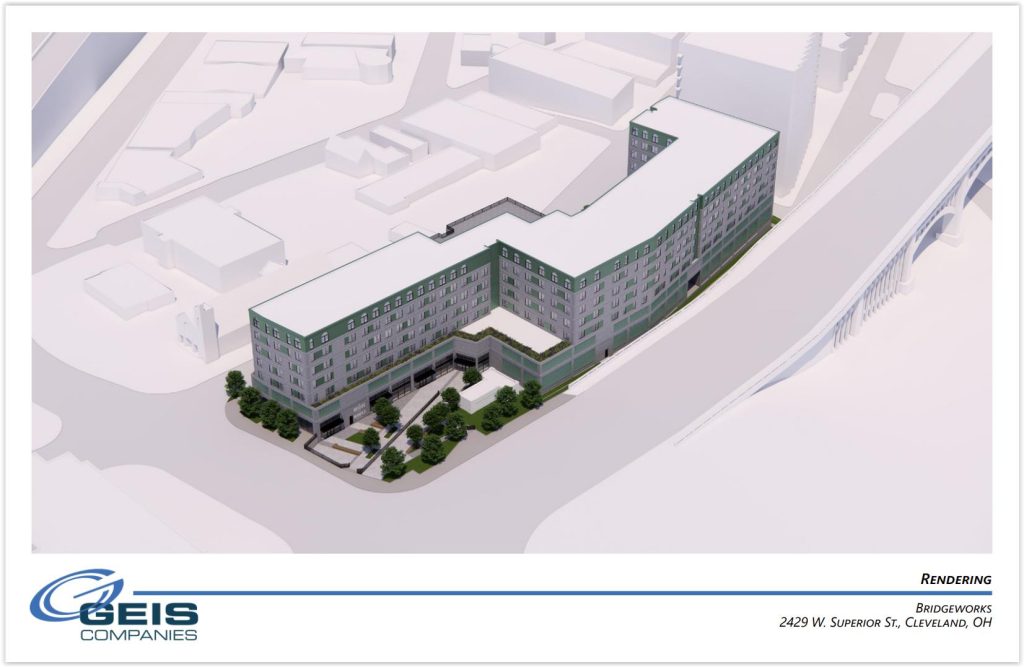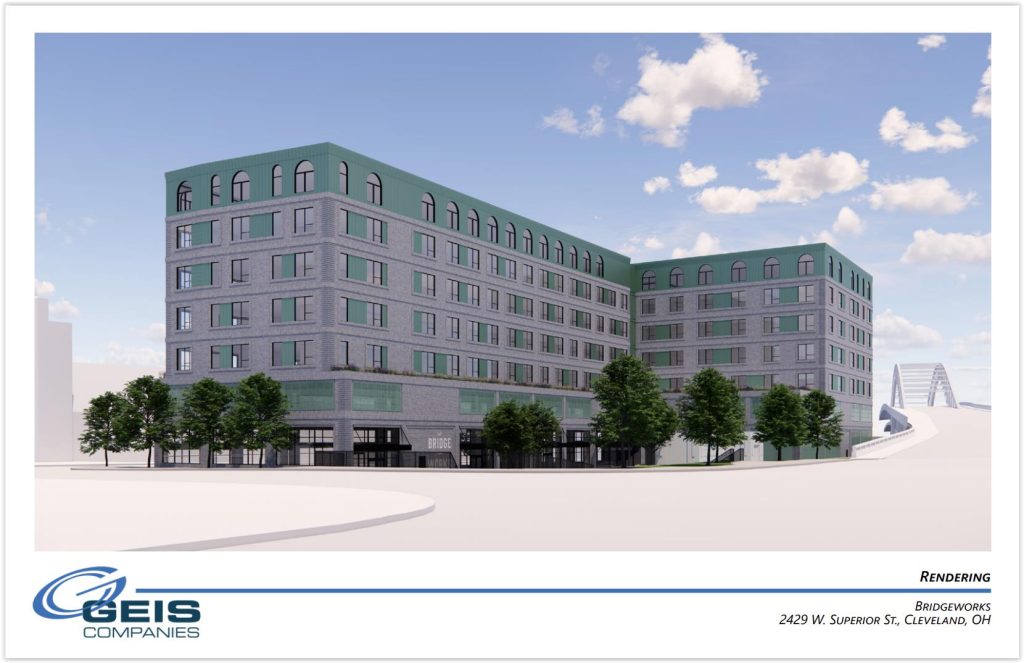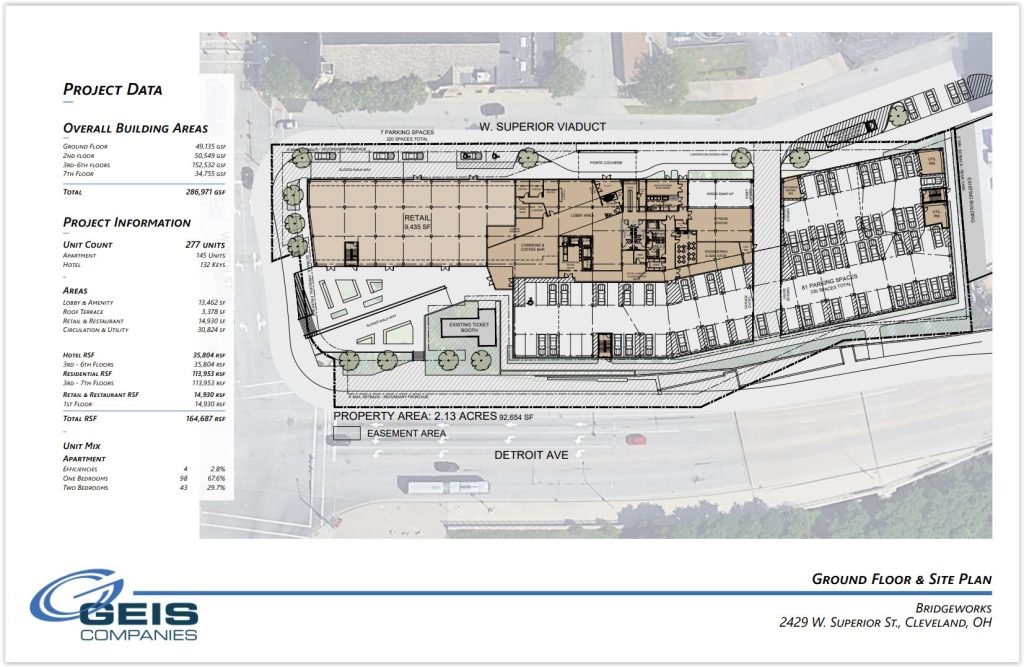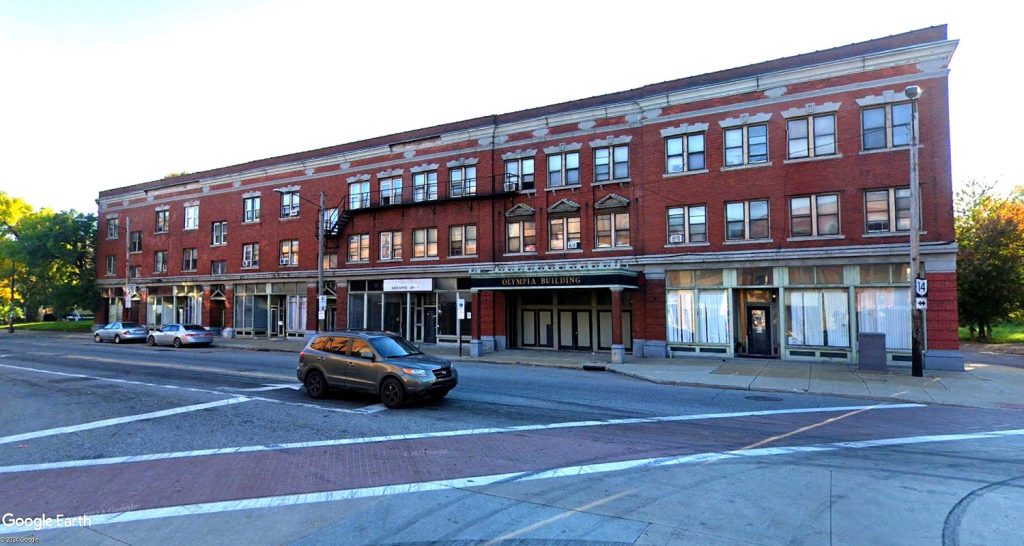
In Cleveland’s Hingetown section of Ohio City, Bridgeworks’ new design will likely make a return to city review boards starting next week with an eye toward demolition work and possibly construction later this year. The proposed development would rise at the northeast corner of West 25th Street and the Detroit-Superior Bridge (GLSD). CLICK IMAGES TO ENLARGE THEM.
Landmarks, design-review hearings due this month
Bridgeworks, a mixed-use development proposed in Cleveland’s Hingetown section of Ohio City and that’s gone through several iterations, will be back in front of city design-review panels this month in the hopes of getting construction started this year. If approvals are granted, demolition of existing buildings at the northeast corner of West 25th Street and the Detroit-Superior Bridge could start in the coming months.
The development team seeking to deliver Bridgeworks will be presenting a refined version of the same concept which NEOtrans was first to report on in September 2023. That design is a more affordable version of a high-rise design that was previously sought by the developers Bridgeworks LLC, a partnership of M Panzica Development and Grammar Properties, both of Cleveland.
A seven-floor, 146-unit apartment building is planned to be mixed with a 132-key Cleveland Motto By Hilton hotel, 6,933-square-foot restaurant-kitchen on the top floor, about 9,000 square feet of ground-floor commercial space, and a 213-space, two-level parking garage. Proposed are 81 parking spaces on the first level, 132 on the second level plus additional on-street parking. The apartments are to be workforce units and offered at more affordable rates.
On Feb. 23, Bridgeworks’ design-build-property management firm, Cleveland-based Geis Companies, submitted to the city a demolition permit for the vacated former Cuyahoga County Engineers’ laboratory and garage on the 2.13-acre site. The Bridgeworks joint venture acquired the site from the county in 2021, public records show.
In the unique world of Cleveland real estate development, a prospective developer typically must first get their project proposal rejected by the city’s Building Department and receive an explanation as to why. That rejection and explanation was sent to Geis architects on March 8 by city Zoning Administrator Shannan Leonard.
“At this point you have the option of either changing your plan/application to comply with the zoning code, or seeking a variance from the zoning code on one or more of the cited items,” Leonard wrote.
The cited items were building setbacks on a main street (West 25th) that exceed eight feet and six feet on a secondary street (Vermont Avenue). Also, frontage buildout (amount of a building oriented toward a street) of 80 percent of main street frontage is required with only 53 percent frontage buildout proposed. Secondary street frontage buildout of 100 percent is required, but only 71 percent secondary street frontage buildout is provided, Leonard noted.
Furthermore, she said the project must get final design approval from the city’s Landmarks Commission. Since this is the routine for submitting projects for approval in Cleveland, none of this came as a surprise to Brandon Kline, vice president of design at Geis. He said his firm is also submitting the project for consideration by Planning Commission’s Design Review Committee.
“These items of non-conformance were anticipated and expected,” Kline told NEOtrans. “We have filed and requested a BZA (Board of Zoning Appeals) hearing” for a variance to the setbacks and frontage. He said he hopes to go before Design Review next week and Landmarks in two weeks.
The demolition work needs to start soon. Bridgeworks received a $223,500 grant from the Ohio Brownfield Remediation Program in 2022 to pay for site clean-up, demolition and clearing of the site. If the grant is not used in a timely manner, it must be returned to the Ohio Department of Development.
Demolition costs were estimated at $320,000, according to a demolition permit application submitted to the city in August 2023. No updated cost estimate was provided in last month’s application which is proposing basically the same work as in the prior request.
While the county engineers building is to be demolished and its parking lots removed, a 117-year-old subway ticket booth on the site will be preserved for reuse in the new development. A streetcar subway ran on the lower level of the Detroit-Superior Bridge until 1954 and won $7 million in federal funds today for its reactivation as a public space. Last month’s demolition application was Bridgeworks third; the first came in 2021. Demolition permits typically expire after one year.
Project financing from the city, Cuyahoga County and Cleveland-Cuyahoga County Port Authority was arranged last spring and reportedly remains in place. The Port Authority’s Board of Trustees in April 2023 authorized the issuance and sale of $80 million in taxable Lease Revenue Bonds plus $4.13 million of taxable Bond Fund Tax Increment Financing Bonds. Also last April, Cuyahoga County Council awarded Bridgeworks a $2 million Place-Based/Mixed-Use Economic Development Loan.
A month before, Cleveland City Council approved a 30-year tax-increment financing (TIF) agreement for Bridgeworks. The TIF diverts the increase in future non-school property taxes based on the proposed improvements for up to 30 years though it does not exempt the developer from payments in lieu of taxes (PILOTS) to ensure the Cleveland Metropolitan School District receives what it would have otherwise received if not for the TIF.
The high-rise version of Bridgeworks was estimated to cost at least $108 million, a number that kept growing as interest rates and the cost of materials rose. Souces familiar with the project said that, after a construction lender reportedly pulled out, the developers were forced to reduce the construction cost of the project by reducing its 162-foot height to just 85 feet. Other projects nationwide have been slowed or stopped by rising costs and reduced lending.
Not only was Bridgeworks’ design changed last year, so was its development team. General contractor Turner Construction Co. with an office in Cleveland and project designer LDA architects, Inc., based in Cleveland, were both ousted in favor of Geis. But the sources said LDA and Turner had offered a mid-rise plan similar to what Geis is now proposing.
END





